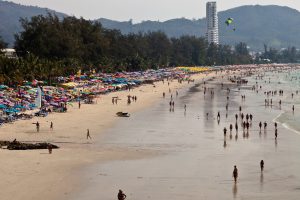By Sebastian Strangio

It has long been acknowledged that the health impacts of the coronavirus pandemic could eventually be dwarfed by the economic effects of the measures designed to bring the contagion under control. Since March, when the World Health Organization official declared COVID-19 a pandemic, the world has seen a cascade of depressing economic projections: an ocean of red ink sprayed the world’s economic balance-sheets.
The latest entry in this catalog of economic gloom came on September 29, with the publication of the World Bank’s latest report on the East Asia and Pacific region.
The report claims that due to the economic downturn unleashed by COVID-19, the number of poor people in the region is set to rise for the first time in 20 years. Despite its relative success in containing the pandemic, the region is likely to witness a rapidly growing class of “new COVID poor,” with up to 38 million people set to remain mired or fall back into poverty by the end of 2020.
The report landed just as the global death toll from COVID-19 surpassed 1 million, according to data compiled by Johns Hopkins University.
The World Bank observes that the the pandemic has unleashed a “triple shock” on the economies of East Asia and the Pacific: the impact of the pandemic itself, the economic impact of containment measures and the regional impacts of the broader global recession. As a result, even nations that have successfully contained the virus are unlikely to be insulated from its economic effects.
Even with the inclusion of China, which has seen a better than expected recovery from the pandemic, the World Bank expects the developing economies of East Asia and the Pacific to grow between 0.3 and 0.9 percent this year, the lowest rate since the 1960s. When China is taken out of the equation, however, this turns into a regional annual contraction of between 3.5 and 4.8 percent.
“Public and private indebtedness, along with worsening bank balance sheets and increased uncertainty, are likely to inhibit public and private investment, as well as pose a risk to economic stability,” the report states. “Sickness, food insecurity, job losses, and school closures could lead to the erosion of human capital and earning losses that last a lifetime.”
According to the report, the 38 million “new poor” brings the number of people living under the poverty line in the region to 517 million, an increase of nearly 8 percent since last year, and a reversal of the steady upward trend of recent decades. Given the prevalence of informal employment across much of the region, the economic effects of COVID-19 are expected to fall particularly heavily on women.
According to the World Bank, the hardest-hit economies include those most exposed to the global collapse in tourism and exports. This crisis is therefore tailor-made for Southeast Asia. The Bank’s “low case” economic projections estimate an annual collapse in GDP totaling up to 6.1 percent in Malaysia, 9.9 percent in the Philippines, and a whopping 10.4 percent in Thailand. Taken together, the economies of the developing Southeast Asian nations – the ten members of the Association of Southeast Asian Nations minus Brunei and Singapore – could contract by as much as 4.7 percent in 2020.
This is all the more worrying given that several Southeast Asian nations, including Indonesia, the Philippines and Myanmar, continue to grapple with serious outbreaks of the disease.
The regional bright spot is Vietnam, which has managed to balance the imperatives of public health and economics. According to the World Bank, its economy could grow by as much as 2.8 percent this year – the highest of any nation in East Asia or the Pacific.
If the past is any indication, economic contractions of this magnitude can be expected to flow into political crises. Southeast Asia’s last serious economic downturn – the Asian financial crisis of 1997-98 – had a profound impact on the region’s politics, catalyzing the turbulent collapse of the Suharto regime in Indonesia, the ascent of Thaksin Shinawatra in Thai politics, and the reformasi movement in Malaysia. Thailand in particular is witnessing escalating political unrest, with similar stirrings also taking place in neighboring Cambodia. Given past precedent, it would be surprising if the political ferment ended there.
The World Bank’s bleak assessment suggests that the economic effects of COVID-19 will still be with us, long after the fever breaks.
No comments:
Post a Comment